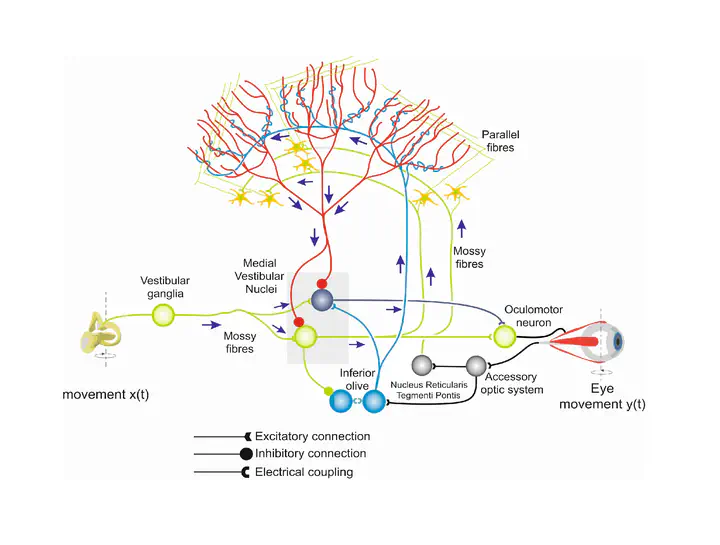SPIKEAGE - Cerebellar Spiking Modelling Accounting for Human Ageing Degradation in Motor Adaptation
 Cerebellum-dependent adaptation of Vestibulo-Ocular Reflex (VOR). Horizontal rotational VOR (i.e., r-VOR) stabilizes the visual field during horizontal head rotations, x(t), by producing contralateral eye movements, y(t)
Cerebellum-dependent adaptation of Vestibulo-Ocular Reflex (VOR). Horizontal rotational VOR (i.e., r-VOR) stabilizes the visual field during horizontal head rotations, x(t), by producing contralateral eye movements, y(t)
As life expectancy increases, better understanding of ageing in health and well-being becomes crucial in advanced societies. Ageing causes neural degradation in some neural subsystems responsible for equilibrium and orientation. Falls increase exponentially with age, mostly due to failures in equilibrium, i.e. the rate of hospital admission due to falls for people aged 60 and older ranges from 1.6 to 3.0 per 10 000 population (Australia, Canada and UK). Consequently, falls in elderly are becoming a major public concern due to their social, economic and health costs (i.e. in 2007 the average hospitalisation cost for fall related injury for people 65 yo and older ranges from €5 595 in Ireland to €14 717 in US. This cost is projected to increase and sum up US$ 240 billion by year 2040) Vestibular control of eye movements contributes to maintain equilibrium and spatial orientation, thence, understanding the age-related biological degradation in vestibular control is pivotal in combating falls in the elderly.
SPIKEAGE focuses on the cerebellum, a brain region that mediates the vestibular control coordination of eye movements being the vestibular ocular reflex (VOR), the most studied reflex of them all. VOR generates rapid contralateral eye movements that maintain images in the fovea as the head rotates/translates and preserves clear vision thus playing a fundamental role in maintaining balance through gaze stability. We will model and evaluate the cerebellar neural basis of VOR adaptability in rotatory VOR specific tasks. Additionally, age-related changes in VOR functionality will be put in relation to the underlying morphological cerebellar age-related changes beneath.
SPIKEAGE sets forth a multidisciplinary methodology in studying neural ageing that combines phenomenological, functional, and neural perspectives by using a holistic modelling approach. Simulated neural models will guarantee full access to the cerebellar system properties, which will be assessed through both qualitative and quantitative performance indicators to facilitate a constructive cross-validation against age-related neurophysiological data. This approach will also allow us to predict new functional roles of specific cell/network/neural-plasticity properties and provide explanation on the computational cues of the cerebellar micro – circuitry adaptation related to ageing. The goal of SPIKEAGE lies on moving forward the knowledge frontiers in integrative/computational neuroscience, and ageing, thus boosting our Research Team at the cutting-edge of these research fields.